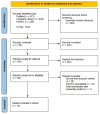Balance Rehabilitation through Robot-Assisted Gait Training in Post-Stroke Patients: A Systematic Review and Meta-Analysis
- PMID: 36672074
- PMCID: PMC9856764
- DOI: 10.3390/brainsci13010092
Balance Rehabilitation through Robot-Assisted Gait Training in Post-Stroke Patients: A Systematic Review and Meta-Analysis
Abstract
Background: Balance impairment is a common disability in post-stroke survivors, leading to reduced mobility and increased fall risk. Robotic gait training (RAGT) is largely used, along with traditional training. There is, however, no strong evidence about RAGT superiority, especially on balance. This study aims to determine RAGT efficacy on balance of post-stroke survivors.
Methods: PubMed, Cochrane Library, and PeDRO databases were investigated. Randomized clinical trials evaluating RAGT efficacy on post-stroke survivor balance with Berg Balance Scale (BBS) or Timed Up and Go test (TUG) were searched. Meta-regression analyses were performed, considering weekly sessions, single-session duration, and robotic device used.
Results: A total of 18 trials have been included. BBS pre-post treatment mean difference is higher in RAGT-treated patients, with a pMD of 2.17 (95% CI 0.79; 3.55). TUG pre-post mean difference is in favor of RAGT, but not statistically, with a pMD of -0.62 (95%CI - 3.66; 2.43). Meta-regression analyses showed no relevant association, except for TUG and treatment duration (β = -1.019, 95% CI - 1.827; -0.210, p-value = 0.0135).
Conclusions: RAGT efficacy is equal to traditional therapy, while the combination of the two seems to lead to better outcomes than each individually performed. Robot-assisted balance training should be the focus of experimentation in the following years, given the great results in the first available trials. Given the massive heterogeneity of included patients, trials with more strict inclusion criteria (especially time from stroke) must be performed to finally define if and when RAGT is superior to traditional therapy.
Keywords: balance; gait; rehabilitation; robotics; stroke.
Conflict of interest statement
The authors declare no conflict of interest.
Figures





References
Publication types
LinkOut - more resources
Full Text Sources

